The AMD Trinity Review (A10-4600M): A New Hope
by Jarred Walton on May 15, 2012 12:00 AM ESTAMD Trinity: Battery Life Also Improved
With all of the changes going into Trinity, one thing that hasn’t changed since Llano is the process technology. Trinity is once again coming on a 32nm process from GlobalFoundries. If we were talking about Intel, Trinity would represent a “Tock” on the roadmap—a new architecture on an existing process. We’ve looked at CPU and GPU performance, and this is a part that’s pretty much universally faster than its predecessor. Given the lengthier pipeline and Bulldozer-derived architecture, I admit that I was concerned Trinity might actually be a step back for battery life; it appears that my fears were unfounded, largely due to the improvements in Piledriver. As usual, we tested with all laptops set to 100 nits brightness in our idle, Internet, and H.264 playback tests. I also ran some additional tests which we’ll discuss in a moment. First, here are the standard battery life results:
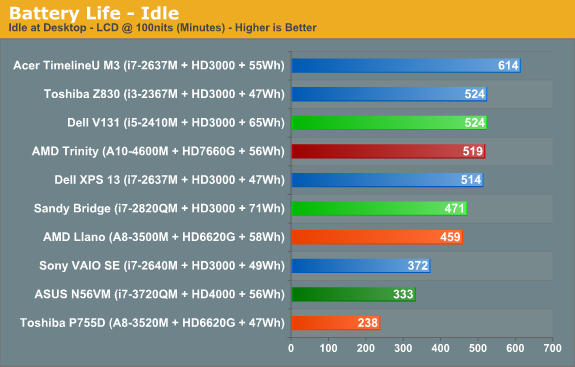
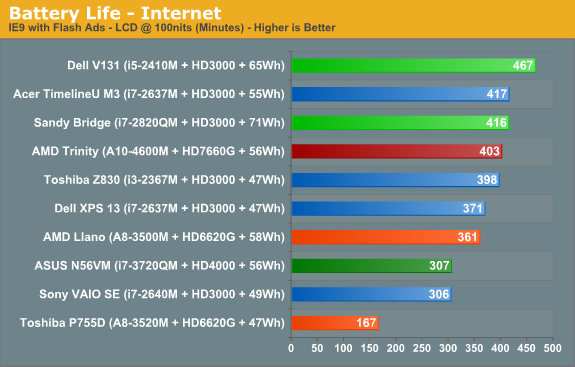
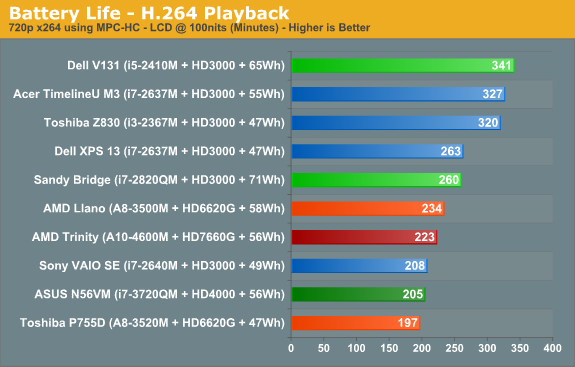
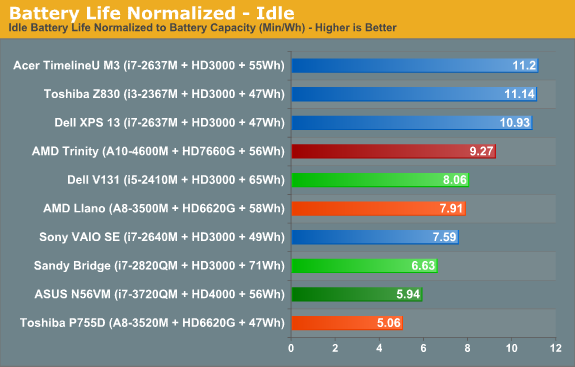

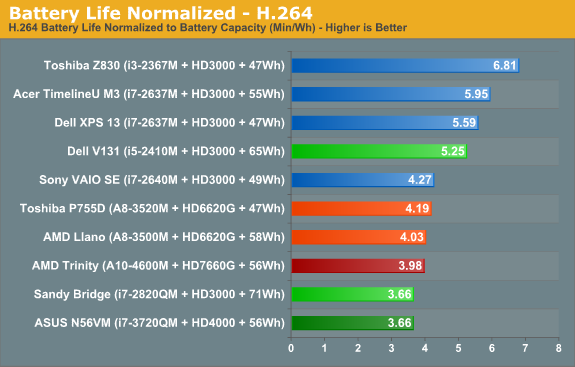
With a similar capacity battery to the original Llano laptop, and the same size 14” panel, Trinity comes out of the gates and posts two clear wins: idle battery life and Internet battery life are both up substantially relative to Llano. In fact, looking at the normalized charts, the only laptops that can consistently beat Trinity are found in Sandy Bridge ultrabooks—we won’t even bother discussing Atom or Brazos netbooks, as they’re competing in a completely different performance bracket. In something of a surprise, H.264 battery life doesn’t see the same benefit unfortunately, and it’s the one discipline where Llano still holds on to a slight lead over Trinity. Sandy Bridge meanwhile has always done very well in H.264 battery tests, and we see that with the Vostro V131 posting a normalized score that’s 30% better than Trinity and Llano. Of course, on the other end of the spectrum we have Ivy Bridge; we’ve only looked at one Ivy Bridge laptop so far, but if the pattern holds than Ivy Bridge will generally be a moderate step back in battery life relative to Sandy Bridge, giving AMD an even larger lead in this area.
We also performed a few other tests that we won’t present in graph form. One set of tests we alluded to earlier: the charts show Trinity with a Samsung 830 SSD, but we also ran tests with an Intel 520 SSD. Idle battery life dropped to 476 minutes (an 8% decrease), Internet battery life checked in at 371 minutes (down 8% again), and H.264 battery life stayed nearly the same at 217 minutes (down less than 3%). If battery life is one of your primary concerns, remember: all SSDs are not created equal!
Another test that we ran is simulated gaming; we looped the four graphics tests in 3DMark06 at 1366x768 until the battery ran out. We’ve run this same test on quite a few other laptops, and Llano initially looked to be far and away the best solution. Later, we discovered that when we tested Llano we were letting the GPU run in power saving mode—basically half the performance you’d get compared to being plugged in. We retested and measured 98 minutes, so the extra graphics performance comes with a heavy cost. We only tested Trinity (and Ivy Bridge and Sandy Bridge) using higher performance graphics settings, and this is one more area where it scores worse than Llano: Trinity managed just 77 minutes. That’s about the same as Ivy Bridge and Sandy Bridge (79 and 73 minutes, respectively), so if you’re after better gaming performance while running off the mains, you might need to keep looking.
Before getting too carried away with the above results, you still need to consider how important battery life is for your usage model. Some people travel a lot and like to go all day without plugging in; others will go from place to place and plug in whenever they’re not on the go. If you fall in the latter category, battery life isn’t usually a problem with any decent laptop, while those looking for all-day computing will definitely want as much mobility as possible. Ultimately, battery life is a factor of battery capacity as well as power optimizations done by the OEMs. We’ve seen battery life improve by as much as 50% when comparing two otherwise similar notebooks, but at least AMD’s reference platform for Trinity delivers a great starting point.
Temperatures and Acoustics
One other item we wanted to quickly touch on is system temperatures. We typically use HWMonitor and check temperatures of laptops under idle and load conditions. We did this with Trinity as well, but unfortunately the current version of HWMonitor doesn’t give us a lot of information. The only temperatures it reports are from the SSD and the HD 7660G graphics—there’s nothing about CPU core temperatures. That means we can’t provide much detail, other than to say that load temperature on the GPU topped out at 71C during extended testing, while the idle temperature was 39C. As usual, temperatures and noise levels go hand in hand, and the low 71C maximum GPU temperature matches up nicely with noise levels that never got above 37dB. It’s not the quietest laptop we’ve ever tested, and surface temperatures can get a little warm, but overall Trinity looks to be a good balance of performance and power requirements, which means quiet laptops are definitely possible.










271 Comments
View All Comments
Burticus - Tuesday, May 15, 2012 - link
I wonder if they will release standalone mobile chips and if they are the same socket as the current Llano? Currently my laptop has an A8-3500 and I wouldn't mind upping to an A10.They did this in the past with the S1 socket, I wonder if it will be an option nowadays...
For the most part I've been pretty impressed with the A8 for a $500 laptop (especially with some overclocking). Games are playable at moderate settings. Civ 5 still kicks it in the teeth though, and I see that the A10 got a 10fps jump which would be nice.
JarredWalton - Tuesday, May 15, 2012 - link
The sockets are different: FS1r2 this time. I don't know precisely what changed, but apparently it's enough that AMD isn't making them backwards compatible.Fallen Kell - Tuesday, May 15, 2012 - link
The biggest problem with the design is that the OS doesn't know how to work with the CPU. Take the case where you have 2 of these piledrivers, with 1 floating point intensive job and 1 non-floating point intensive job already running, in which case the OS will place the first job, on one piledriver, and the next on the other piledriver. Then a user starts a new floating point intensive job, and the OS simply puts it on the next free core, which happens to be the one already running a floating point intensive application, and thus, you just bottlenecked both of those processes. The OS doesn't know if a process is floating-point heavy or not, and thus, can not properly schedule it to a core which has a floating point unit not in heavy use. That is why bulldozer failed. It is also why my work will never purchase it, as they do floating point intensive applications.Beenthere - Tuesday, May 15, 2012 - link
Most every reviewer has indicated that Trinity is a significant jump in performance in both CPU and GPU with extended battery performance yet some reviewers seem hard pressed to admit that for 90% of the laptop market Trinity is superior to Intel's best offerings.Some reviewers are trying to pretend that Intel's faster CPU performance some how is of importance to the majority of the laptop market when in fact it is not unless all you do is crunch numbers. I think Trinity sales just like llano and brazos will drive the point home who is leading the laptop market segment with what consumers actually desire.
JarredWalton - Tuesday, May 15, 2012 - link
Beenthere, you have to be the biggest AMD fanatic I've seen around here. EVERY article where AMD comes up, you're there making things up to justify your worldview. As I indicate in the article, Trinity is 10-20% faster than Llano on CPU and 20% faster on GPU, which is a decent improvement. Unfortunately, a lot of places are quoting AMD's "up to 29% faster CPU and 56% faster GPU" and calling it a day. Those are results that just didn't show up in any testing that I conducted.Oh, wait, I've got one: using OpenCL in GIMP, Trinity is 72% faster than Llano! There, we now have one statistic you can point to where Trinity is better. For the 0.1% of the population that uses GIMP, and not even them really -- it's the 0.1% of people that use GIMP and will some day benefit when the next major release comes out and incorporates OpenCL. If you can't see the problem with that statement, I can't help you.
For 90% of the market, Trinity might be enough, but to say it's "better than Intel's best" is pure fanaticism and nothing more. You are more biased than AMD's own marketing department. To pretend that moderately faster graphics with substantially less CPU performance is somehow more important than any other metric is insane. Sandy Bridge with GT 540M can be had for $600 right now, and it will beat Trinity in pretty much every single metric. Lucky for AMD, a lot of people like you will blindly purchase anything with AMD on it without regard for reality.
bji - Tuesday, May 15, 2012 - link
While I agree with your points overall, I think there is a fine detail you need to consider:Benchmarks are only an approximation of the performance results that would be achieved on a whole variety of processor tasks. You can rightly point out that only a small fraction of tested programs benefitted greatly from improved OpenCL performance, but you can't claim that this only benefits the 0.1% of people that use GIMP and care about OpenCL, because there may be other programs available now, or in the future, that would see similar performance increases. What your benchmarking shows is that *most* programs don't see a huge OpenCL performance benefit, but that *some* do. This is likely to lead to a more significant performance benefit than would be enjoyed by 0.1% of the users of a particular application.
However, I think that CPU reviewers are kind of in a hard place these days, since we're arguing over how big of an overkill one given processor is than another when considered for a wide variety of tasks, which starts to make any benchmarking about trying to find benchmarks where the performance difference would really matter. And that invites all kinds of debate about which kinds of performance actually matter to the average user, which is not a very fun or interesting argument.
CPU performance can still matter for targeted tasks, but that kind of analysis requires a very different approach and is very user-specific, when compared to standard benchmarking.
JarredWalton - Tuesday, May 15, 2012 - link
You're correct, and the real difficulty is first in finding anything where OpenCL is clearly faster, and then seeing similar techniques used in other software. Office for example isn't going to really get any faster because of you GPU or OpenCL -- and it doesn't need to be. Office spends its time waiting for user input. So what we really need are technologies that make the slow parts of using a computer faster. SSDs are a perfect example, because they make the initial boot and application load times all faster. OpenCL isn't doing that for the vast majority of applications, and neither is Quick Sync or DirectX or whatever other GPU related task you want to throw out there. They make graphics faster, but in my experience that's mostly important to gamers, or for high-end workstation stuff where you want OpenGL support.For many people, Core 2 Duo is fast enough, and Llano is fast enough, and Trinity is fast enough, etc. So for those users, it's about delivering the lowest cost. Trinity is twice the size of quad-core Ivy Bridge, so Intel could easily start a price war if they wanted, but they'd rather keep higher margins. Sandy Bridge laptops at $600 are still faster for general use than Llano and Trinity, particularly if they have an Optimus GPU around. Unless something is significantly faster in some important metric -- and I really don't see any single area where that's the case for Trinity -- then you just get whichever is the best price.
Beenthere - Tuesday, May 15, 2012 - link
Wow, Jarred is having an unhappy day! :(Obviously AMD's testing is different than your's as is other websites. My comments were NOT in regards to your article, which I though was pretty balanced. The website I was referring to is listed below.
Your knee-jerk reaction to my comment however shows you're loosing it. If you really believe that Intel's platform provides as good a result for mainstream consumers, you'd be in error especially when Trinty Ultrathins will be hundreds cheaper.
It's pretty obvious you can't deal with differing POVs and you get upset when you're opinion is not shared by others. Losing your objectivety makes it difficult for anyone to take your articles seriously - even though this one was pretty balanced. You should consider a CHILL PILL before over-reacting.
You really should THINK before you react. In this case my comment had NOTHING to do with your story. If your article has merit then you should not need to go POSTAL even if my comment was about your story. Being a reactionary and calling people names for having a different POV than you shows immaturity. The really funny part about your knee-jerk reaction was my comment was in regard to another story on Trinity on a different website. (see below).
You must have a guilty conscience? Below is the story I commented on. Oops, I'm sure you are embarrassed now, but it's OK? I don't hold grudges. <LOL>
Maybe the Intel fanbois are just beating you up too much because Trinity is a far better choice for laptops than anything Intel has at the moment? they'll get over it.
http://www.pcper.com/reviews/Mobile/AMD-A10-4600M-...
Cheer up Jarred. You can look forward to Piledriver/Vishera in a few months and more hate from the Intel fanbois.
bji - Tuesday, May 15, 2012 - link
Sorry, but when you start a paragraph with "Some reviewers are trying to pretend" you are VERY CLEARLY implicating that the reviewer is being dishonest by trying to mislead people reading the review by stating intentionally false commentary.If you start with that kind of premise, then you deserve a response that, in kind, accuses you of doing the same, which is exactly what you got.
Trying to then pretend that you're innocent and didn't deserve that response is just more lameness.
JarredWalton - Tuesday, May 15, 2012 - link
Beenthere is your typical passive aggressive anonymous Internet poster. I called him on his post, and now he backpedals. You know what's hilarious, Beenthere? That article you link. Let me give you a quote from the conclusion to show what I'm talking about:"I can’t find a way to look at Trinity that paints a favorable picture. Though certainly an improvement over Llano, it’s not enough. AMD is way behind Intel in processor performance, and the graphics performance does not offer redemption. The only way systems based off Trinity will be made competitive is by slashing and burning the prices."
Okay, that's pretty much what I said as well. Perhaps they're even more negative than I am. And yet... that paragraph is followed by a Silver Award? WTF is up with that? They're awarding something that they can't find a way to describe in a positive fashion? And then you suggest that "Some reviewers are trying to pretend that Intel's faster CPU performance some how is of importance to the majority of the laptop market when in fact it is not unless all you do is crunch numbers." I'd say the opposite: some reviewers are trying to kiss up to AMD with an award or backhanded praise when everything else they say is negative at best.
But hey, let's not forget how open and unbiased Beenthere is. Here's a quote from page three of the comments that shows his amazing analytical skills and not-at-all-anti-Intel mindset:
Subject: Excellent by Beenthere on Tuesday, May 15, 2012
As expected Trinity delivers in all areas and should meet most people's needs quite well. Good job AMD. You get my money!
Wow. Yup, Trinity is a far better choice for laptop than anything Intel has at the moment. Because Acer's AS4830TG with GT 540M and i5-2410M at $600 offers better CPU performance and better GPU performance. Yup. Far better. I like to pay more for less!